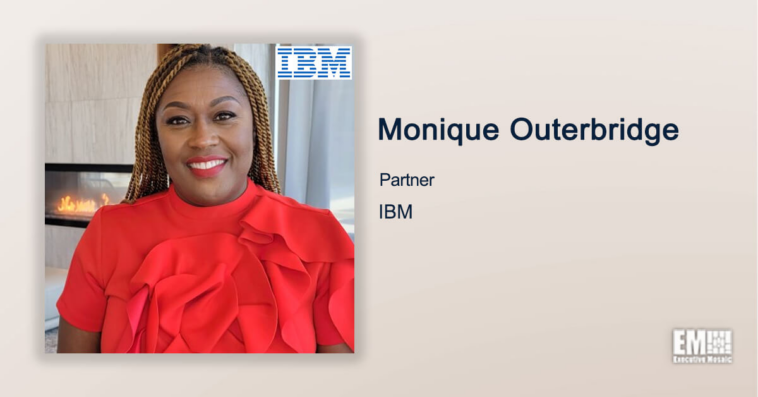Monique Outerbridge, partner at IBM, recently spoke with ExecutiveBiz regarding her growth strategy as the company drives new opportunities and expands its healthcare portfolio and capabilities in the federal landscape.
In addition, Outerbridge also discussed how IBM is working to assist federal agencies with the modernization of their core systems and operations, plus her strategic goals for 2022.
“What does data analytics look like and how can that process provide information that would change and impact things like health outcomes, equity issues, timeliness and being able to meet more urgent needs. Data is at the crux of all those issues. It’s a journey and one of the most exciting for me. I believe taking on that direct challenge is a necessity.”
You can read the full Executive Spotlight interview with Monique Outerbridge below:
ExecutiveBiz: What can you tell us about your growth strategy to drive new opportunities for IBM’s federal health portfolio? What are the most significant challenges facing federal agencies like the Food and Drug Administration (FDA), Centers for Medicare and Medicaid Services (CMS) and National Institutes of Health (NIH)?
“As a former client myself, I understood coming into IBM three and a half years ago that our business development strategy for federal healthcare agencies couldn’t simply be about selling the latest technologies and services.
We have to first have a deep understanding of each agency’s mission, challenges and needs, and only then are we able to offer the right solutions. I chose to join IBM because I knew that the company believed in and practiced this same approach.
I and my colleagues have spent our careers in the federal healthcare and life sciences space. Some of the best solutions to our client’s challenges come from team brainstorming sessions. Understanding and investing in our federal government clients is a big part of IBM’s growth strategy.”
ExecutiveBiz: How is IBM working to assist federal agencies with the modernization of their core systems and operations, as well as improving citizen engagement and data access for the latest changes in federal health?
“It goes without saying, but we talk about this quite often and there’s a lot to discuss. It’s the stuff that won’t make the five o’clock news, but it’s also the stuff that our clients care most about in this sector.
Navigating the modernization of our federal government infrastructure is a dynamic challenge, and the past two years have put those efforts to the test. Federal agencies have had to reshuffle and reprioritize efforts, and yet the goal has remained the same: to leverage the right technologies and applications to improve operational efficiencies and make data actionable.
The government has a lot of data – it represents a huge latent source of value for the sector. In fact, I believe that data is the question and answer to the IT modernization challenge. If used and acquired effectively, prioritizing security and privacy, interoperable and connected government data – coupled with technologies and applications like automation and artificial intelligence – has the potential to simplify delivery of public services, positively impact health outcomes and equity issues, enable massive operational efficiencies – and this is just the beginning.
Regardless of these potential benefits however, legacy technologies and organizational data silos sometimes inhibit government’s ability to effectively capture the opportunity. I’m intrigued by the related possibilities for federal health. It’s a necessary journey and one of the most exciting for me.”
ExecutiveBiz: What can you tell us about IBM’s objectives for 2022 in the federal health sector? How do you see the impact of the pandemic continuing to influence the sector?
“COVID-19 has put the spotlight on IT modernization and the need to adapt quickly. It has challenged the status quo by encouraging government to explore the boundaries of what they’re capable of – and while there’s been some technology enabled success – IBM’s priority is partnering with our federal government clients to make these successes business as usual.
We know that bringing together the right ideas, technologies, data, and people at the right time can lead to powerful insights. Keeping this in mind, as we move forward, I want IBM to be seen as a strong healthcare and life sciences partner to the federal government. We’re keeping pace with this vision and I’m excited about the future.”





